Color Rendering of New Home Designed for Woodside, California
This residence is being proposed for the community of Woodside, California. The precise location has to be confidential, but it’s going to be a wonderful addition to the area, which is known for its love of horses, ranches, and beautiful properties. Designed by Pacific Peninsula Architecture of Menlo Park, California, the residence has a classic farmhouse vibe–almost historic or preservation-oriented in its attitude. It is of course new construction but the design reaches out to traditional structures built years ago in the area, bridging the gap between the existing and the newly-constructed. Mainly composed of siding and trim, all is painted white, with window trim and doors of a rich dark blue-gray as minimal accent to the white. The detached garage is a departure from that scheme–but again reaching out to traditional building in the area with its weathered, natural wood–as if it is a barn which has been there for years. Landscaping plans are being developed by Thomas Klope, with layered planting, interlocking pavers, and maintaining many large existing trees on the site. The redwoods in front of the house in this view are all existing and will remain. As an architectural illustrator, I have been working with Pacific Peninsula for about 25 years. Their designs are always thoughtful and responsive to the clients wishes, when required, as not all of PPA’s projects involve a specific client. A certain amount of their residential work is speculative, meaning that it is built to be sold in the open market, without a specific client in mind. To an architect, those are two very different mindsets-but PPA is adept at both approaches and that’s one of many reasons they have been so successful over the years. As for me, I am hoping we continue this good relationship, and I look forward to many more projects together in the years to come !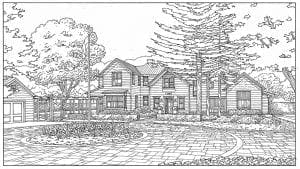

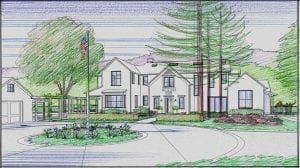

Two Watercolor Renderings of Large San Jose Mixed Use Project
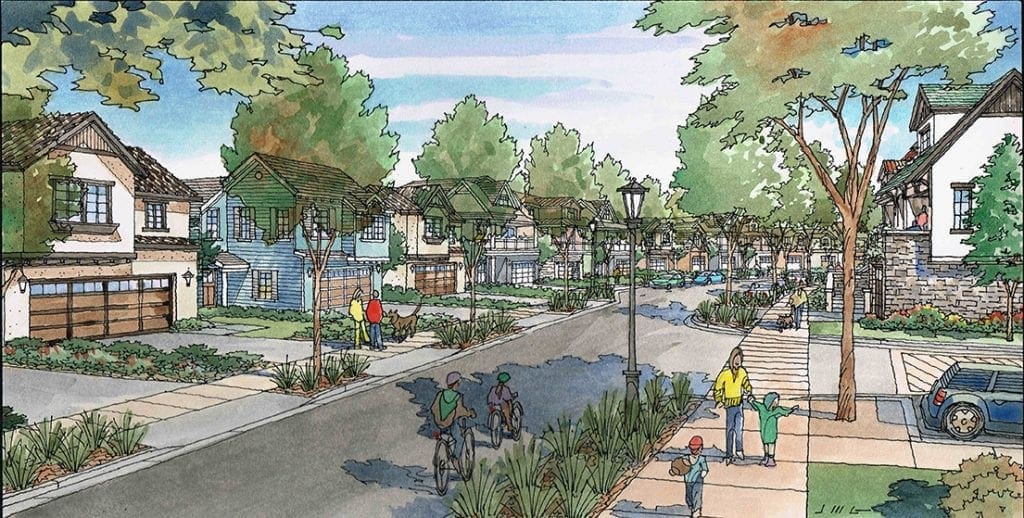 These two architectural renderings are the last two of a series of eight illustrations for this project. It’s a large mixed use project envisioned for the City of San Jose (Cambrian area). Cambrian Park Village designed by Ken Rodrigues + Partners of Mountain View, California and KTGY Architects of California, is located at a major intersection of Camden Avenue and Union Avenue, which is currently the site of an older shopping center. The overall project includes a six-story apartment building, a five-story Hotel, a five-story Assisted Living Facility, two-story condominiums, and some single-family houses. Although I have done many renderings for all of these elements, today I am featuring the single family homes. Mostly two-story with some three-story residences, these homes comprise a residential neighborhood of tree-lined streets. There’s a neighborhood park and a tot lot, walkable sidewalks, and some traffic-calming features within the design. The idea is that you could walk to work within this overall development since there are so many varied types of buildings and functions within the same neighborhood–each located next to one another. For example in one of these views we see the edge of the park as it gives way to the houses. But that same park, if you take a different path or direction would lead to the apartment building, hotel, or assisted living facility. So, possibly there is no need for a commute to work. Or maybe the park is a lunchtime retreat for parents bringing up children and health care workers alike. This is the kind of social interactivity that urban designers have strived to achieve for years with their designs. And these designers rely on renderings such as these to express their ideas and communicate the concepts to the public. An architect can show plans and elevations while presenting in a public forum, but the audience lights up when they see hand-drawn renderings that capture the spirit of the design.
These two architectural renderings are the last two of a series of eight illustrations for this project. It’s a large mixed use project envisioned for the City of San Jose (Cambrian area). Cambrian Park Village designed by Ken Rodrigues + Partners of Mountain View, California and KTGY Architects of California, is located at a major intersection of Camden Avenue and Union Avenue, which is currently the site of an older shopping center. The overall project includes a six-story apartment building, a five-story Hotel, a five-story Assisted Living Facility, two-story condominiums, and some single-family houses. Although I have done many renderings for all of these elements, today I am featuring the single family homes. Mostly two-story with some three-story residences, these homes comprise a residential neighborhood of tree-lined streets. There’s a neighborhood park and a tot lot, walkable sidewalks, and some traffic-calming features within the design. The idea is that you could walk to work within this overall development since there are so many varied types of buildings and functions within the same neighborhood–each located next to one another. For example in one of these views we see the edge of the park as it gives way to the houses. But that same park, if you take a different path or direction would lead to the apartment building, hotel, or assisted living facility. So, possibly there is no need for a commute to work. Or maybe the park is a lunchtime retreat for parents bringing up children and health care workers alike. This is the kind of social interactivity that urban designers have strived to achieve for years with their designs. And these designers rely on renderings such as these to express their ideas and communicate the concepts to the public. An architect can show plans and elevations while presenting in a public forum, but the audience lights up when they see hand-drawn renderings that capture the spirit of the design.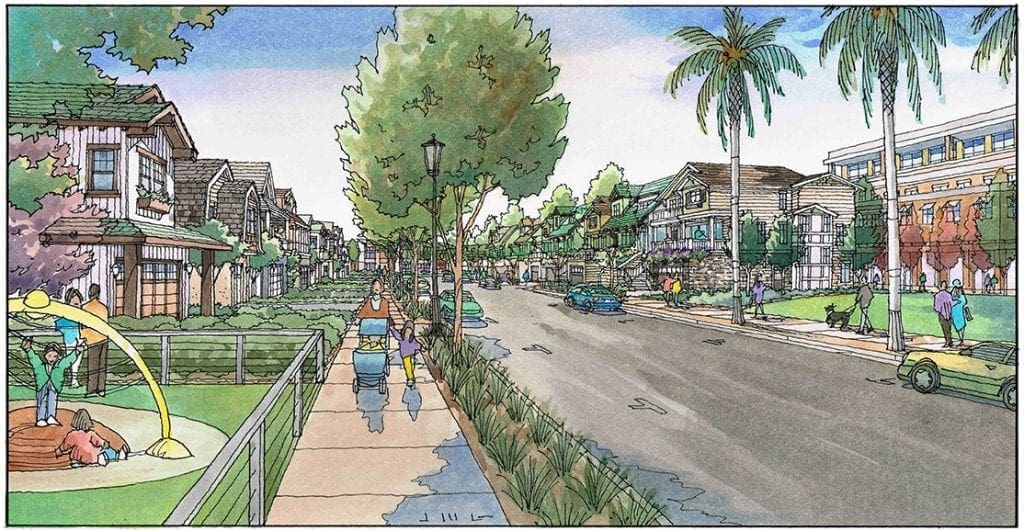
Finished Watercolor of Falling Water by Jeffrey Michael George
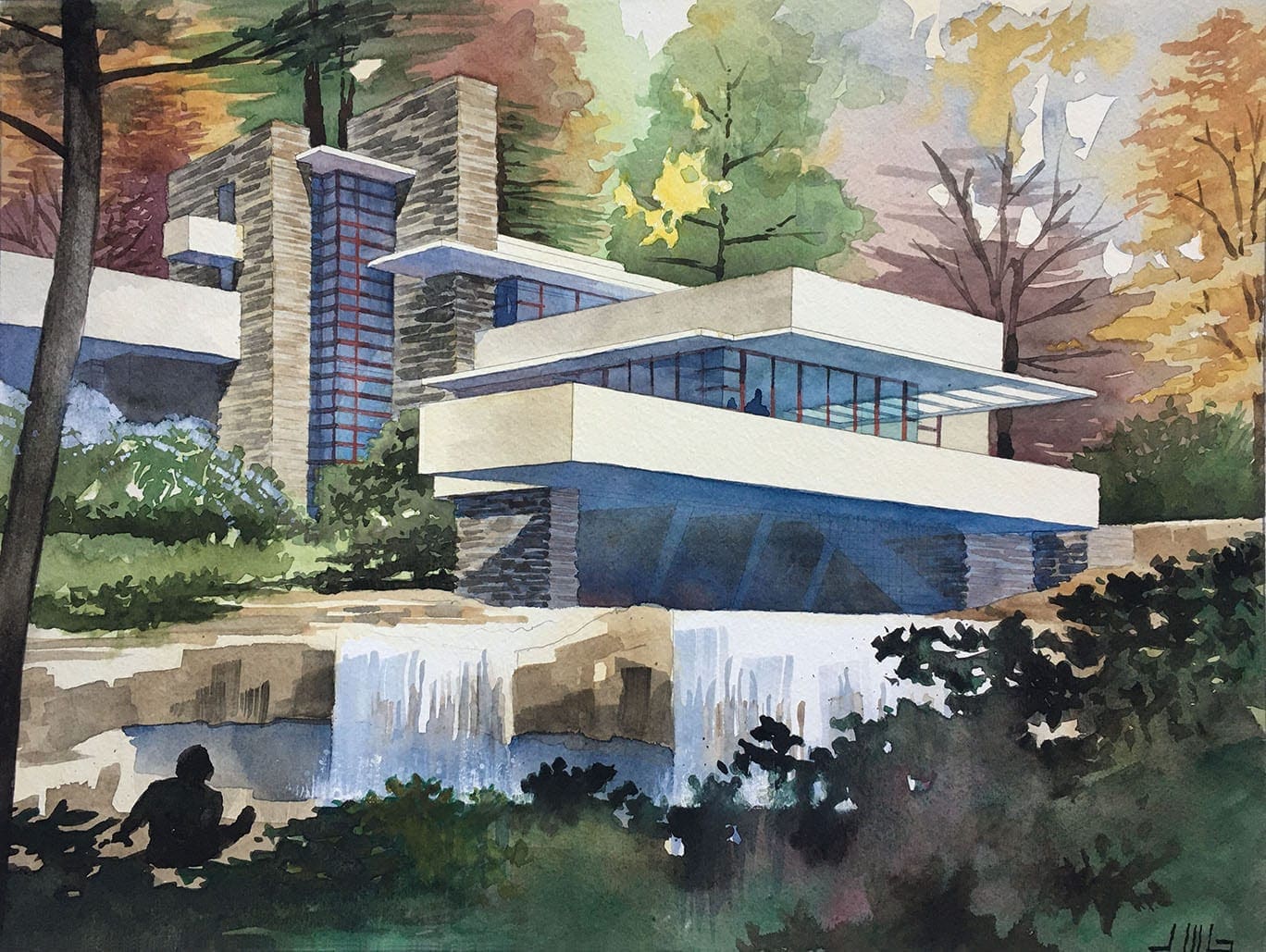 Here is my finished watercolor painting, along with the progress shots along the way, of Frank Lloyd Wright’s Falling Water” residence….Since my architectural illustration practice usually involves deadlines and time crunches, it’s nice to paint something that doesn’t need to be done at any particular time….and I enjoy the subject matter immensely….Actually this painting is the second in a series of watercolor paintings I have planned that feature the great works of architecture of the 20th Century….I enjoy exploring a new medium, and playing around with the possibilities….as with anything, the more you do it, the more comfortable it is, and the more comfortable you get with trying new methods–basically having more fun with it….There’s a greater sense of freedom because this is not a commissioned work–I’m just doing it for my own amusement….As an artist, the goals are to use a full range of values, to use complementary colors, and when the work is finished, it should have a focus–a place for the eye to go comfortably and effortlessly. Since this painting features a Frank Lloyd Wright design, I wanted to tie the architecture to the natural setting quite closely, by using the same color palette as much as possible in both architecture and landscape. Wright was a proponent of “organic architecture” as he called it–the idea being that buildings spring into the imagination by the greatest teacher–Nature itself….and you are honoring Nature by paying great attention to it and not copying it, but instead learning its principles, appreciating it, and then expressing your own unique designs which are inspired by it….One way I tried to convey that in this painting was to treat the horizontal elements of the building similarly to the horizontal ledges of the waterfall below the house, as if the house has been formed into the same shape as the stone of the waterfall–by nature….
Here is my finished watercolor painting, along with the progress shots along the way, of Frank Lloyd Wright’s Falling Water” residence….Since my architectural illustration practice usually involves deadlines and time crunches, it’s nice to paint something that doesn’t need to be done at any particular time….and I enjoy the subject matter immensely….Actually this painting is the second in a series of watercolor paintings I have planned that feature the great works of architecture of the 20th Century….I enjoy exploring a new medium, and playing around with the possibilities….as with anything, the more you do it, the more comfortable it is, and the more comfortable you get with trying new methods–basically having more fun with it….There’s a greater sense of freedom because this is not a commissioned work–I’m just doing it for my own amusement….As an artist, the goals are to use a full range of values, to use complementary colors, and when the work is finished, it should have a focus–a place for the eye to go comfortably and effortlessly. Since this painting features a Frank Lloyd Wright design, I wanted to tie the architecture to the natural setting quite closely, by using the same color palette as much as possible in both architecture and landscape. Wright was a proponent of “organic architecture” as he called it–the idea being that buildings spring into the imagination by the greatest teacher–Nature itself….and you are honoring Nature by paying great attention to it and not copying it, but instead learning its principles, appreciating it, and then expressing your own unique designs which are inspired by it….One way I tried to convey that in this painting was to treat the horizontal elements of the building similarly to the horizontal ledges of the waterfall below the house, as if the house has been formed into the same shape as the stone of the waterfall–by nature….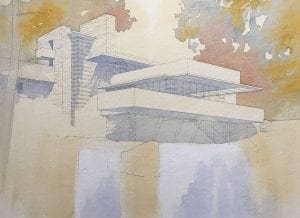
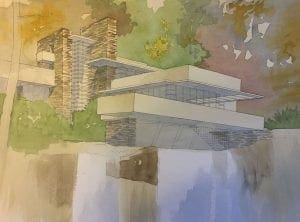

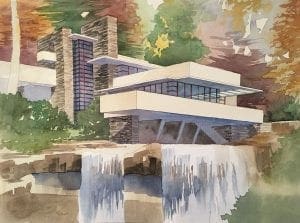
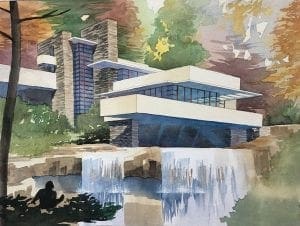
Architectural Rendering of Church Property
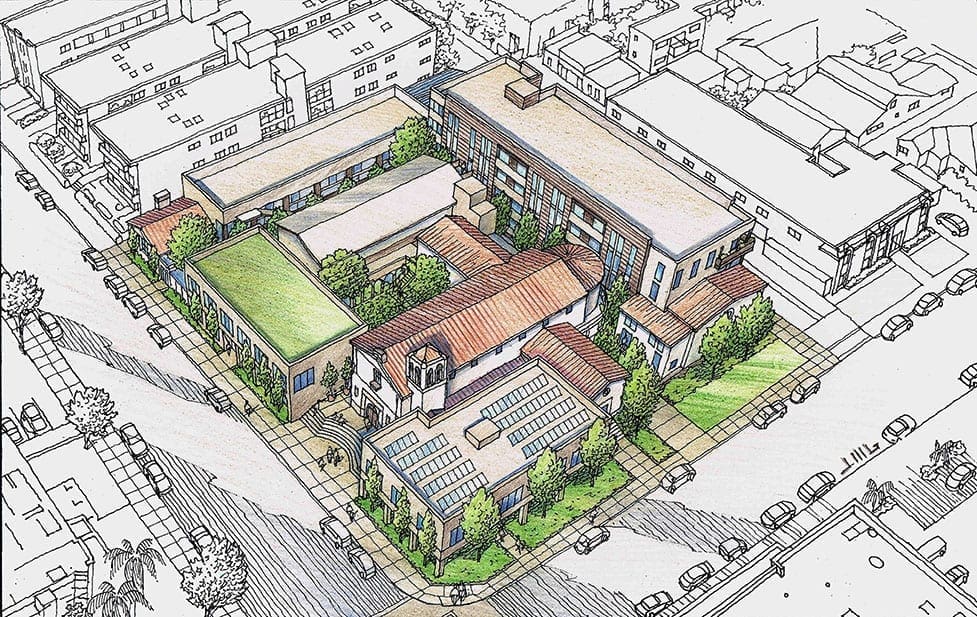 This color rendering I recently completed for an existing church in Southern California is another example of how to illustrate proposed changes to a property. My client for this project is Shelter Architects of Pasadena, California. They did the architectural design for the property, which involves renovating older buildings on the site, and building some new buildings in order to upgrade and modernize the facility. The church occupies most of a city block in an urban area of Los Angeles, so an overall view from above the site seemed to be the best angle to describe the architect’s design. But what’s interesting about the rendering itself is that we decided to color only the church property–and leave the surrounding neighborhood context uncolored. Obviously, the church property becomes a focus for the viewer, due to the color. As always there is a black and white original drawn of the rendering prior to applying the color, which I have included here. Normally I would intentionally tone down the coloring of the surrounding area in the rendering, and accentuate the church property with clearer, brighter colors to distinguish it from the background. But in this instance we achieved the same effect by coloring only the subject of the drawing, and leaving the surroundings in black and white. There is economy of time and effort with this method, too. Once the black and white drawing is finished and approved by the client, that’s all that’s necessary for a good portion of the rendering. I have also included a copy of the CAD perspective which the architect provided in the beginning. Could they have simply used this CAD drawing to show their ideas to the church audience ? Of course, but that brings up the question of how well a technical drawing engages the audience–and the answer is, not very well. Something hand-drawn with people, trees, and landscape always engages the audience to a much greater extent than a purely technical, digital image.
This color rendering I recently completed for an existing church in Southern California is another example of how to illustrate proposed changes to a property. My client for this project is Shelter Architects of Pasadena, California. They did the architectural design for the property, which involves renovating older buildings on the site, and building some new buildings in order to upgrade and modernize the facility. The church occupies most of a city block in an urban area of Los Angeles, so an overall view from above the site seemed to be the best angle to describe the architect’s design. But what’s interesting about the rendering itself is that we decided to color only the church property–and leave the surrounding neighborhood context uncolored. Obviously, the church property becomes a focus for the viewer, due to the color. As always there is a black and white original drawn of the rendering prior to applying the color, which I have included here. Normally I would intentionally tone down the coloring of the surrounding area in the rendering, and accentuate the church property with clearer, brighter colors to distinguish it from the background. But in this instance we achieved the same effect by coloring only the subject of the drawing, and leaving the surroundings in black and white. There is economy of time and effort with this method, too. Once the black and white drawing is finished and approved by the client, that’s all that’s necessary for a good portion of the rendering. I have also included a copy of the CAD perspective which the architect provided in the beginning. Could they have simply used this CAD drawing to show their ideas to the church audience ? Of course, but that brings up the question of how well a technical drawing engages the audience–and the answer is, not very well. Something hand-drawn with people, trees, and landscape always engages the audience to a much greater extent than a purely technical, digital image.

Quick Color Sketches in Architectural Presentation
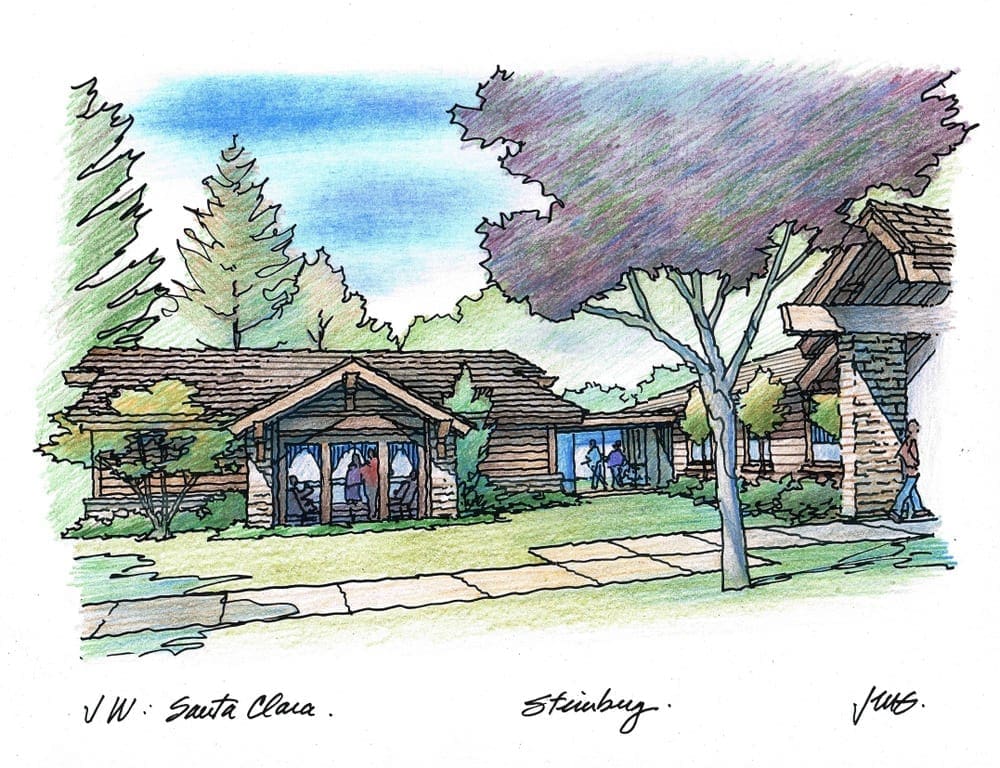 Usually I am asked to provide detailed, refined architectural renderings for my clients. But occasionally I am asked to provide mere sketches as the finished product. I’m going to include some examples of these quicker, looser illustrations today in this blog. When a client calls me and has a project in mind, but no design drawings, I often go this route. The process is kind of like “storyboarding” in the movies. Based on a verbal description, or maybe a photograph or two provided by the client, I start sketching what comes to mind that will help put into pictures what the client has in their mind. It’s fun for me as an artist, and clients really love these sketches. I often describe it as “making something from nothing”. It’s a lot like the “napkin sketch” that one makes in a bar while meeting with someone, and enjoying a beer, and realizing that a quick doodle on the napkin is going to be better than mere words. But of course, my sketches are based on what my client envisions–and what they convey to me in a conversation. And we don’t have to be sitting in a bar, although that sounds kind of good actually. More likely we talk by phone or trade emails, but basically I take their verbal descriptions and create quick sketches in felt pen, occasionally throwing a little color over them to make them a little prettier. Could one do this kind of thing on the computer ? Probably….but I’m still more comfortable with a felt pen and a piece of paper (or a napkin) than I am with a keyboard or a mouse (even though I am using my computer to create this blog episode. I say “an artist is an artist” whether they use the computer or a set of brushes. So, enjoy these few samples I have here, and give me a call if you need something for which “a picture is worth a thousand words”. You can have a beer and tell me about it, and I’ll start sketching in my napkin….
Usually I am asked to provide detailed, refined architectural renderings for my clients. But occasionally I am asked to provide mere sketches as the finished product. I’m going to include some examples of these quicker, looser illustrations today in this blog. When a client calls me and has a project in mind, but no design drawings, I often go this route. The process is kind of like “storyboarding” in the movies. Based on a verbal description, or maybe a photograph or two provided by the client, I start sketching what comes to mind that will help put into pictures what the client has in their mind. It’s fun for me as an artist, and clients really love these sketches. I often describe it as “making something from nothing”. It’s a lot like the “napkin sketch” that one makes in a bar while meeting with someone, and enjoying a beer, and realizing that a quick doodle on the napkin is going to be better than mere words. But of course, my sketches are based on what my client envisions–and what they convey to me in a conversation. And we don’t have to be sitting in a bar, although that sounds kind of good actually. More likely we talk by phone or trade emails, but basically I take their verbal descriptions and create quick sketches in felt pen, occasionally throwing a little color over them to make them a little prettier. Could one do this kind of thing on the computer ? Probably….but I’m still more comfortable with a felt pen and a piece of paper (or a napkin) than I am with a keyboard or a mouse (even though I am using my computer to create this blog episode. I say “an artist is an artist” whether they use the computer or a set of brushes. So, enjoy these few samples I have here, and give me a call if you need something for which “a picture is worth a thousand words”. You can have a beer and tell me about it, and I’ll start sketching in my napkin….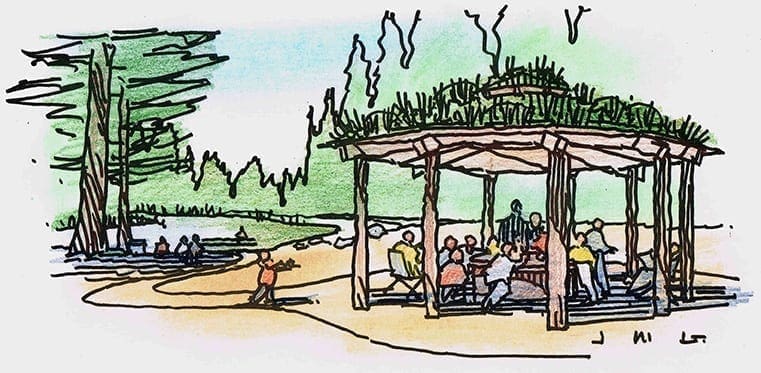
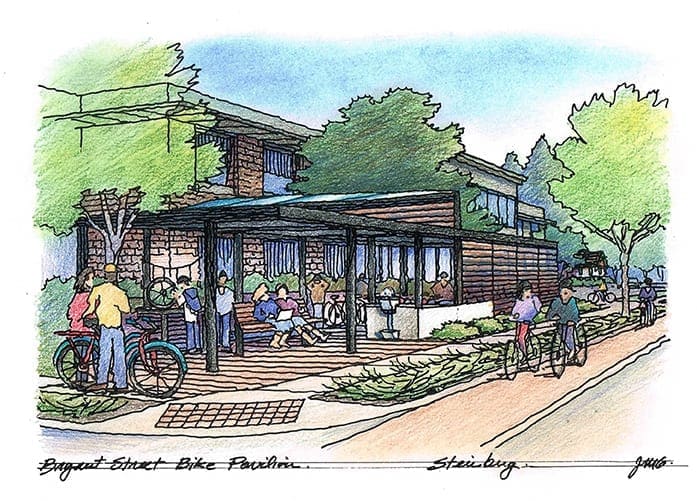
Watercolor Renderings of Veterans Village in San Francisco
These illustrations work well in describing an architect’s ideas to the public. I’ve been told many times that hand-drawn artwork is more successful engaging the public than purely digital representations. There is more of a human element to the hand-drawn artwork than can be achieved with digital 3D modelling and rendering. Today I am featuring four color illustrations I did in 2016, before the project was built.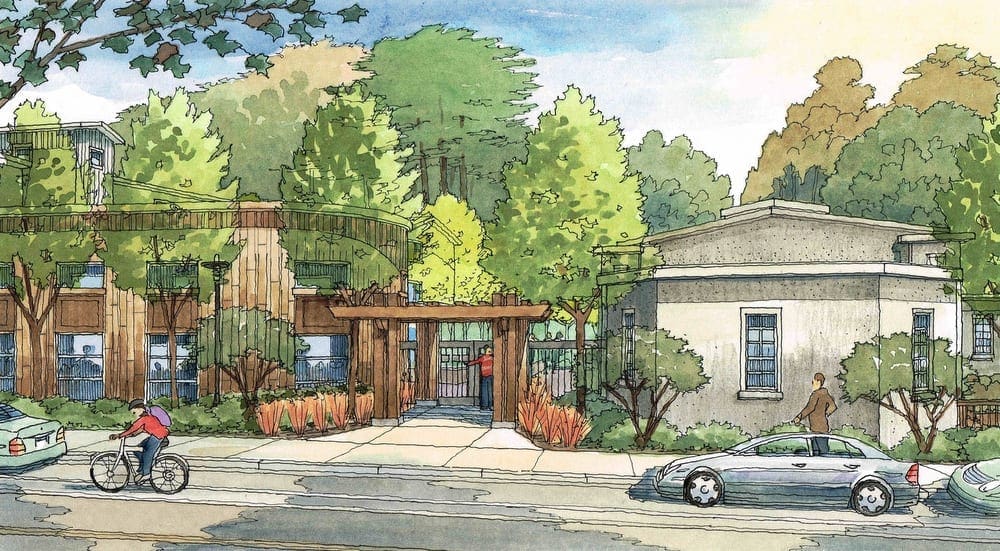 Opened in August of 2019, this is Veterans Village located along Mission Road in Colma, California, which is just south of San Francisco. It’s a veterans facility that has 65 units of housing for vets in their 30’s to 60’s, many of which are transitioning from homelessness. My client was Van Meter Williams Pollack of San Francisco, who designed the entire project back in 2016, and, in turn, their client was Mercy Housing California. The first rendering shows the main entrance to the facility on Mission Road between Cypress Lawn and Holy Cross cemeteries. The gray building on the right in this view is existing and will be renovated and reused. The fun part is showing the people in the renderings–like the shadows of the people inside the building on the left. The second view is of the courtyard looking back at the same two buildings but from the rear of the courtyard–which is what the entrance in the first rendering leads to. This courtyard view shows an enclosed area outside where vets can gather, or just enjoy some quiet time in a safe environment. The third view is what you would see along Mission Road as you approach the facility. This gives the audience an idea of what they will see from this perspective once the project is constructed. There are three buildings overall–one existing, and two new buildings. The fourth and final view shows the housing element of the new facility, which sits along Mission Road, and has parking and its own entrance on the far end, away from the main entry shown earlier.
Opened in August of 2019, this is Veterans Village located along Mission Road in Colma, California, which is just south of San Francisco. It’s a veterans facility that has 65 units of housing for vets in their 30’s to 60’s, many of which are transitioning from homelessness. My client was Van Meter Williams Pollack of San Francisco, who designed the entire project back in 2016, and, in turn, their client was Mercy Housing California. The first rendering shows the main entrance to the facility on Mission Road between Cypress Lawn and Holy Cross cemeteries. The gray building on the right in this view is existing and will be renovated and reused. The fun part is showing the people in the renderings–like the shadows of the people inside the building on the left. The second view is of the courtyard looking back at the same two buildings but from the rear of the courtyard–which is what the entrance in the first rendering leads to. This courtyard view shows an enclosed area outside where vets can gather, or just enjoy some quiet time in a safe environment. The third view is what you would see along Mission Road as you approach the facility. This gives the audience an idea of what they will see from this perspective once the project is constructed. There are three buildings overall–one existing, and two new buildings. The fourth and final view shows the housing element of the new facility, which sits along Mission Road, and has parking and its own entrance on the far end, away from the main entry shown earlier. 

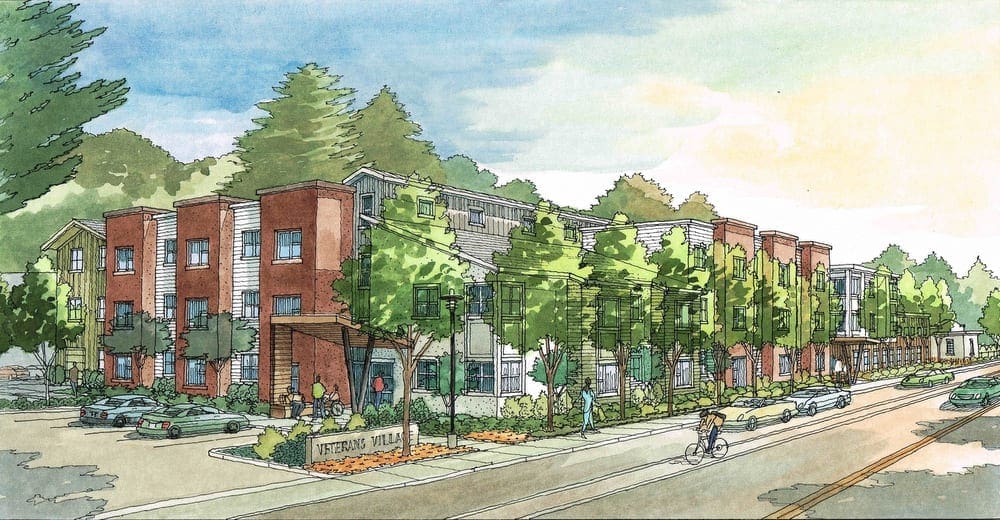
Watercolor Renderings for CCA in Oakland
Here is a series of watercolor illustrations I did in 2016 for Van Meter Williams Pollack Architects of San Francisco, California. These images show the architect’s ideas for adding more housing to the California College of the Arts campus in Oakland. This first view is along Broadway, one or the major streets adjacent to the campus.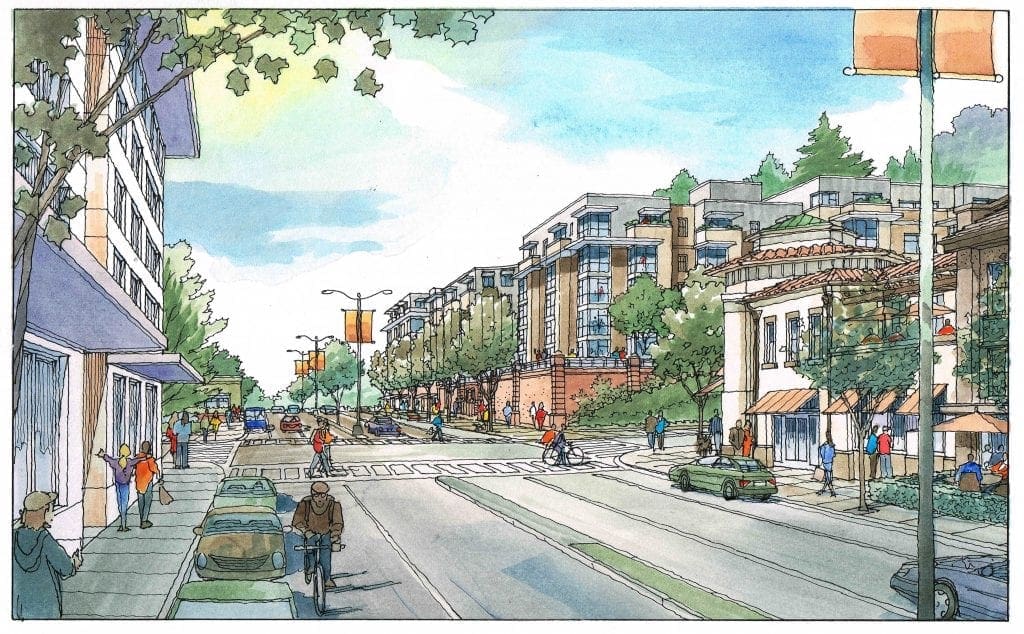 These renderings are intended to show the new buildings and additions in some detail, but mainly to communicate the overall scale and massing of the architect’s design, while including existing buildings and features that are recognizable to the audience–essentially to show a future snapshot if the project were actually built. It’s difficult for the audience to look only at an architect’s plans and elevations, and come away with a clear understanding of how the project would fit in with the neighborhood. So, these renderings serve as a valuable tool of explanation. The second view is also along Broadway, but it taken looking down the major thoroughfare in the opposite direction, from the far corner of the new housing shown in the center of the first rendering. Again there is shown existing context to explain the location, size, and massing of the new building with respect to the existing, with which most are very familiar. The third view is taken from a side street to the building, but a prominent location from which the new addition will be visible–and this rendering shows that clearly. The fourth view is taken from a balcony of one of the new housing units, looking down toward a couple of fine older houses which are a cherished part of the campus. As the artist I try to use a light touch with these illustrations. In the end, the architect (who presents the artwork in a public forum) tells me that they are quite effective. When presented with hand-drawn artwork like this, the audience is receptive, and becomes engaged in a dialogue about the project–something that often does not happen with digital imagery. Purely digital artwork fails to engage the viewer much of the time, giving the audience the mistaken impression that the project is decided already–and I don’t like what I see, particularly the details. Hand-drawn artwork lends the correct impression–that the project is a work in progress, and that we should all talk about it and come to an agreeable conclusion on it.
These renderings are intended to show the new buildings and additions in some detail, but mainly to communicate the overall scale and massing of the architect’s design, while including existing buildings and features that are recognizable to the audience–essentially to show a future snapshot if the project were actually built. It’s difficult for the audience to look only at an architect’s plans and elevations, and come away with a clear understanding of how the project would fit in with the neighborhood. So, these renderings serve as a valuable tool of explanation. The second view is also along Broadway, but it taken looking down the major thoroughfare in the opposite direction, from the far corner of the new housing shown in the center of the first rendering. Again there is shown existing context to explain the location, size, and massing of the new building with respect to the existing, with which most are very familiar. The third view is taken from a side street to the building, but a prominent location from which the new addition will be visible–and this rendering shows that clearly. The fourth view is taken from a balcony of one of the new housing units, looking down toward a couple of fine older houses which are a cherished part of the campus. As the artist I try to use a light touch with these illustrations. In the end, the architect (who presents the artwork in a public forum) tells me that they are quite effective. When presented with hand-drawn artwork like this, the audience is receptive, and becomes engaged in a dialogue about the project–something that often does not happen with digital imagery. Purely digital artwork fails to engage the viewer much of the time, giving the audience the mistaken impression that the project is decided already–and I don’t like what I see, particularly the details. Hand-drawn artwork lends the correct impression–that the project is a work in progress, and that we should all talk about it and come to an agreeable conclusion on it.


Four Watercolor Illustrations for El Paseo de Saratoga Project
Here are four watercolor illustrations I did late 2020 for an aging retail center called El Paseo de Saratoga. Bounded by Quito Road, Saratoga Avenue, W. Campbell Avenue, & Prospect Road, this shopping center would experience a major revitalization with these plans.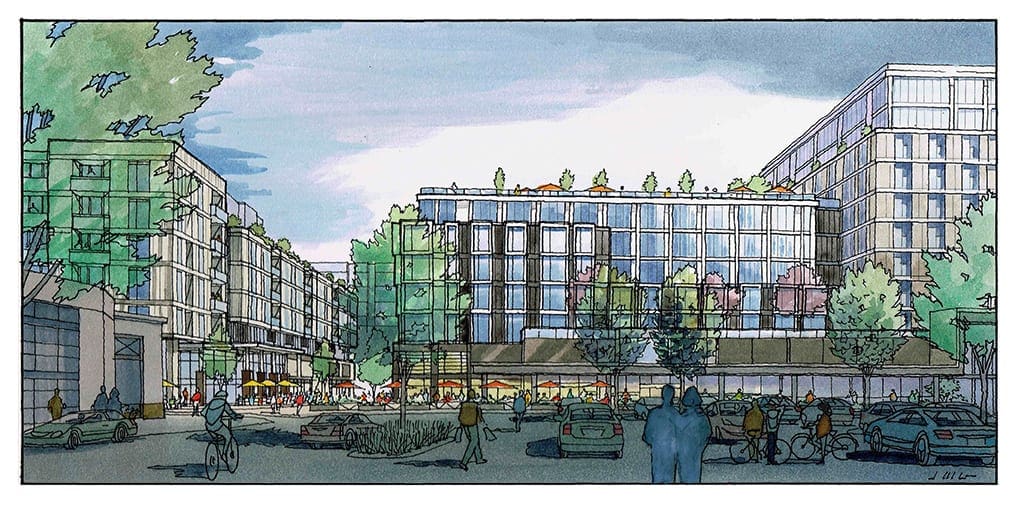 The Architect for the retail element of this project is Kenneth Rodrigues + Partners of Mountain View, California. and he partnered with KTGY Architects of Oakland, California for the design of the office and residential floors above the retail. The perspective views we chose showed the overall project from some key locations–attempting to describe the architectural character that KTGY had in mind for the project. The first view shown here looks at the project from the existing parking area. The idea is to create a living community with full services right there, making day to day life more convenient and less dependent on transportation. Much of the space above the retail is offices, so within this development, you would have a school, restaurants and shops, offices, and residences. We showed not only general massing of the floors above the retail, but even more detail than the previous round of illustrations showed, since more design work had been done at this point. The second view shown here is closer in to the retail corridor, with the Whittle School and bridge shown beyond. As an artist I have tried to use lighting techniques to emphasize the parts of the rendering that I want the viewer to see. These are still preliminary designs, and it’s important to keep the “preliminary feel” in the illustrations. My approach is to show just enough detail that one can understand the scale and character of the building’s design, without going into extraneous detail, which serves only to distract the viewer with issues that can be decided later in the process, when the big picture has been established.
The Architect for the retail element of this project is Kenneth Rodrigues + Partners of Mountain View, California. and he partnered with KTGY Architects of Oakland, California for the design of the office and residential floors above the retail. The perspective views we chose showed the overall project from some key locations–attempting to describe the architectural character that KTGY had in mind for the project. The first view shown here looks at the project from the existing parking area. The idea is to create a living community with full services right there, making day to day life more convenient and less dependent on transportation. Much of the space above the retail is offices, so within this development, you would have a school, restaurants and shops, offices, and residences. We showed not only general massing of the floors above the retail, but even more detail than the previous round of illustrations showed, since more design work had been done at this point. The second view shown here is closer in to the retail corridor, with the Whittle School and bridge shown beyond. As an artist I have tried to use lighting techniques to emphasize the parts of the rendering that I want the viewer to see. These are still preliminary designs, and it’s important to keep the “preliminary feel” in the illustrations. My approach is to show just enough detail that one can understand the scale and character of the building’s design, without going into extraneous detail, which serves only to distract the viewer with issues that can be decided later in the process, when the big picture has been established.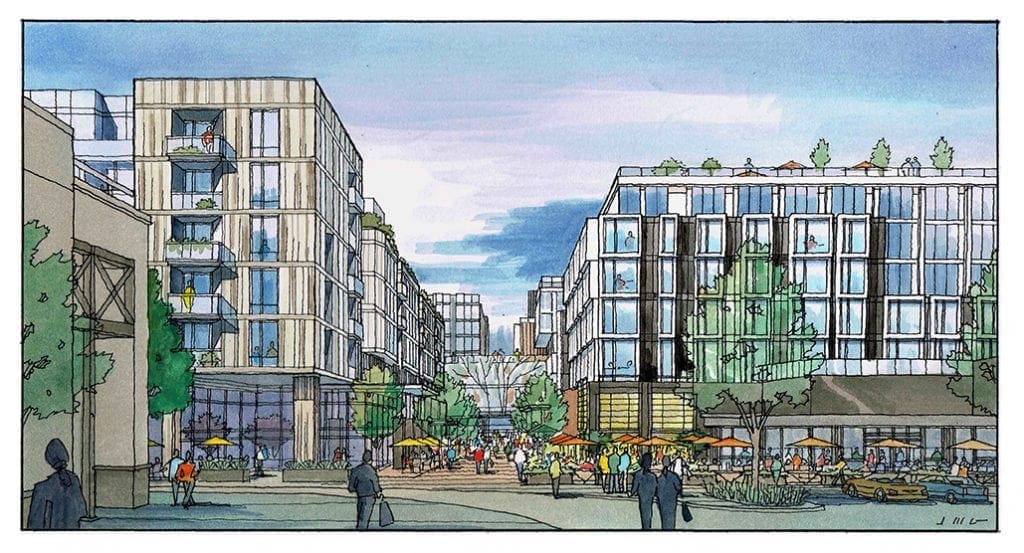
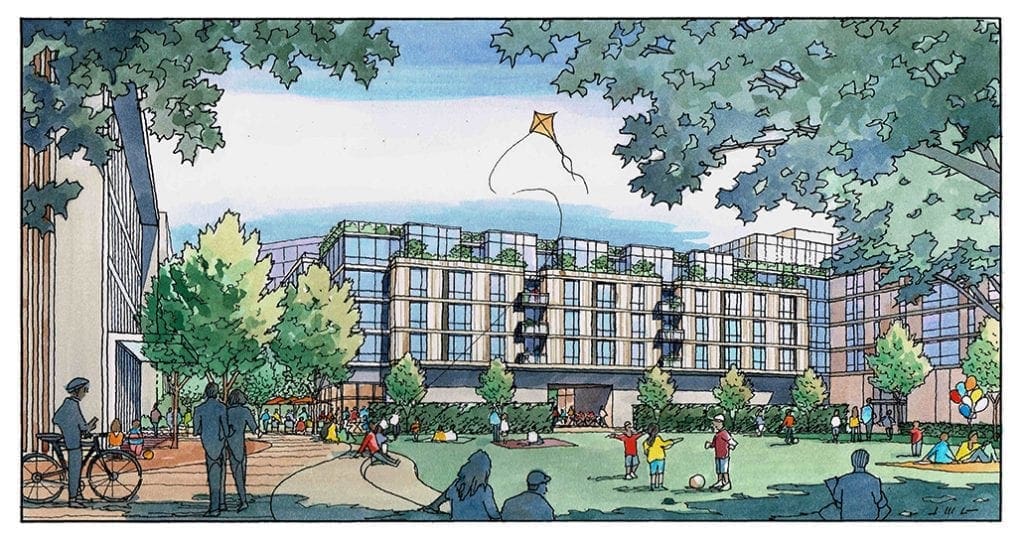

Continuing Watercolor Painting of Frank Lloyd Wright’s “Falling Water”
Since I am currently working on a watercolor painting of this Frank Lloyd Wright house, I am continuing to share the progression toward the finished artwork.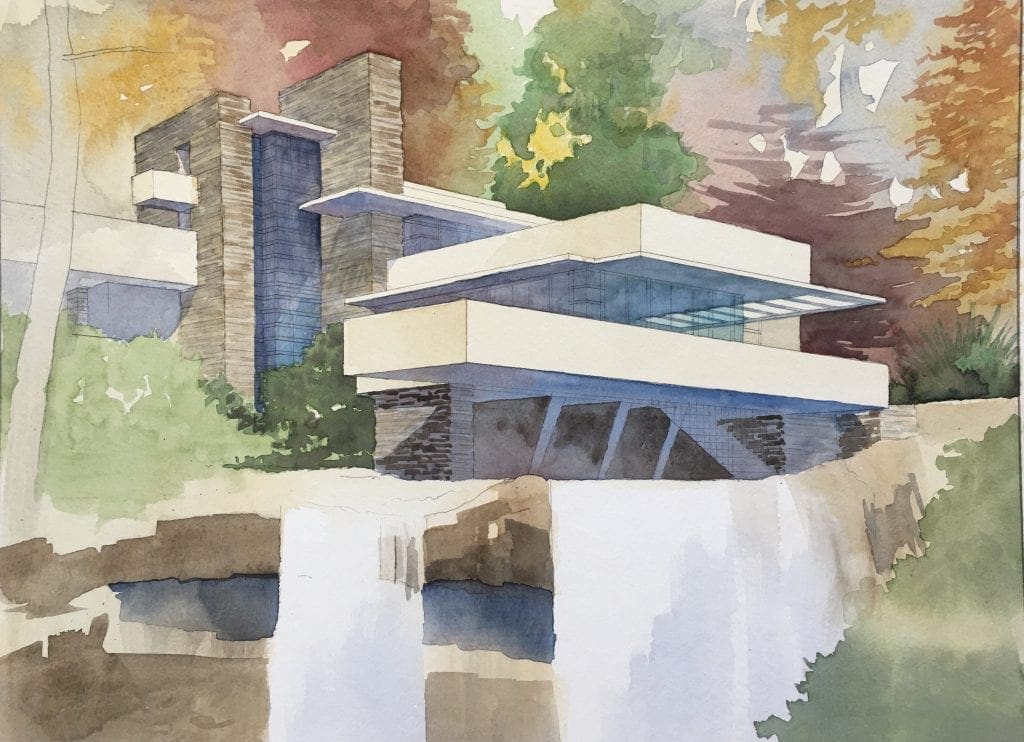 Included here are two more images of the rendering in progress, showing snapshots at various points in the process. I am now getting into the medium tones or mid-tones, basically going from light washes I showed earlier, to somewhat darker (medium range) colors–both warm and cool. None of the colors I am using are pure strong colors, but are blends of greens, reds, yellows. To the greens I am adding brown and gold. To the yellows, I am adding browns and reds, To the blues I am adding a little red. The only pure white areas left are in the waterfall itself–and that is intentional so that in the end, the water falling will be the star of the show. This is consistent with Wright’s convictions that nature is always the most important and most impressive source for any work of art–architecture included. He believed that a house should never sit on top of a hill, but instead sit below the hilltop, serving reverence to the greater beauty of nature at all times. For Wright, nature provided great inspiration–it was not something to be dominated or challenged with one’s work. So in keeping with that, the colors I am choosing are more naturalistic, and the subject of this painting (the house) will not shine as brightly as the natural landscape within which it rests. Nature is the star of this show. In the second image here, you can see I have given more life and detail to the waterfall, using the colors of the rocky cliff behind the water to softly illustrate the falling water in motion. The window frames are a bright red which I have started to indicate here, giving the artwork the next level of detail. Next will be the addition of darker values and colors, so stay tuned for further progress postings.
Included here are two more images of the rendering in progress, showing snapshots at various points in the process. I am now getting into the medium tones or mid-tones, basically going from light washes I showed earlier, to somewhat darker (medium range) colors–both warm and cool. None of the colors I am using are pure strong colors, but are blends of greens, reds, yellows. To the greens I am adding brown and gold. To the yellows, I am adding browns and reds, To the blues I am adding a little red. The only pure white areas left are in the waterfall itself–and that is intentional so that in the end, the water falling will be the star of the show. This is consistent with Wright’s convictions that nature is always the most important and most impressive source for any work of art–architecture included. He believed that a house should never sit on top of a hill, but instead sit below the hilltop, serving reverence to the greater beauty of nature at all times. For Wright, nature provided great inspiration–it was not something to be dominated or challenged with one’s work. So in keeping with that, the colors I am choosing are more naturalistic, and the subject of this painting (the house) will not shine as brightly as the natural landscape within which it rests. Nature is the star of this show. In the second image here, you can see I have given more life and detail to the waterfall, using the colors of the rocky cliff behind the water to softly illustrate the falling water in motion. The window frames are a bright red which I have started to indicate here, giving the artwork the next level of detail. Next will be the addition of darker values and colors, so stay tuned for further progress postings.
Journey’s End Project to Create Housing for Santa Rosa, California
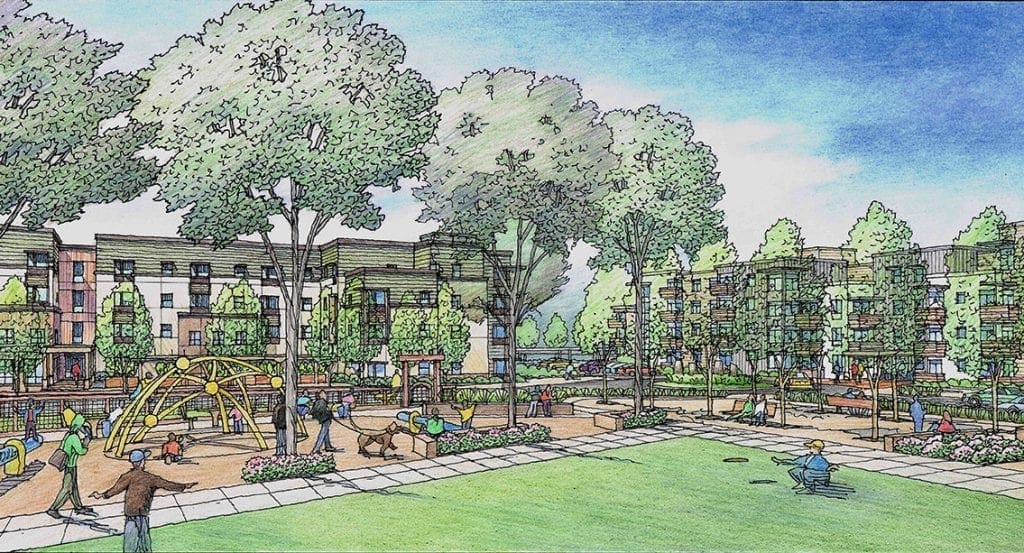 Named for the site of a mobile home park which burned in the 2017 fire in Santa Rosa, this project would provide much-needed housing for the area. Comprised of 370 market-rate apartment units and an additional 162 apartment units for low-income seniors, some displaced by the Tubbs fire, this project encompasses 13.3 acres along Mendocino Avenue. My job was to create the artwork shown here to present the project to the public and the city of Santa Rosa, California. The architect is Van Meter Williams Pollack (VMWP) of San Francisco, California and has been a good client of mine for 30 years. I work as a freelance illustrator when needed for VMWP and many other architects most of whom are located in California. Having a Bachelor’s of Science Degree in Architecture helps me greatly in my work. The ability to read architectural plans and elevations, the ability to do CAD work in 3D programs, and the artistic ability to create color images of unbuilt designs are all parts of my stock in trade. In addition to those skills, one needs to work well with others and be a good team player with other members of the design and presentation team. I feel lucky to be able to do this work for a living–and to have done it for so many years. After being an architectural draftsman, an architectural model builder, and then a drawing assistant to an architectural illustrator–all in the space of 3 years, I began my career as an architectural illustrator on my own in 1983. Much has changed over these years regarding how the work gets done, but much of it remains the same. Whether you are working with a brush or pencil in your hand–or with a mouse and keyboard, you still need an artist’s eye and the ability to work successfully with people to succeed. I hope you enjoy these images I created for the future benefit of Santa Rosa !
Named for the site of a mobile home park which burned in the 2017 fire in Santa Rosa, this project would provide much-needed housing for the area. Comprised of 370 market-rate apartment units and an additional 162 apartment units for low-income seniors, some displaced by the Tubbs fire, this project encompasses 13.3 acres along Mendocino Avenue. My job was to create the artwork shown here to present the project to the public and the city of Santa Rosa, California. The architect is Van Meter Williams Pollack (VMWP) of San Francisco, California and has been a good client of mine for 30 years. I work as a freelance illustrator when needed for VMWP and many other architects most of whom are located in California. Having a Bachelor’s of Science Degree in Architecture helps me greatly in my work. The ability to read architectural plans and elevations, the ability to do CAD work in 3D programs, and the artistic ability to create color images of unbuilt designs are all parts of my stock in trade. In addition to those skills, one needs to work well with others and be a good team player with other members of the design and presentation team. I feel lucky to be able to do this work for a living–and to have done it for so many years. After being an architectural draftsman, an architectural model builder, and then a drawing assistant to an architectural illustrator–all in the space of 3 years, I began my career as an architectural illustrator on my own in 1983. Much has changed over these years regarding how the work gets done, but much of it remains the same. Whether you are working with a brush or pencil in your hand–or with a mouse and keyboard, you still need an artist’s eye and the ability to work successfully with people to succeed. I hope you enjoy these images I created for the future benefit of Santa Rosa !
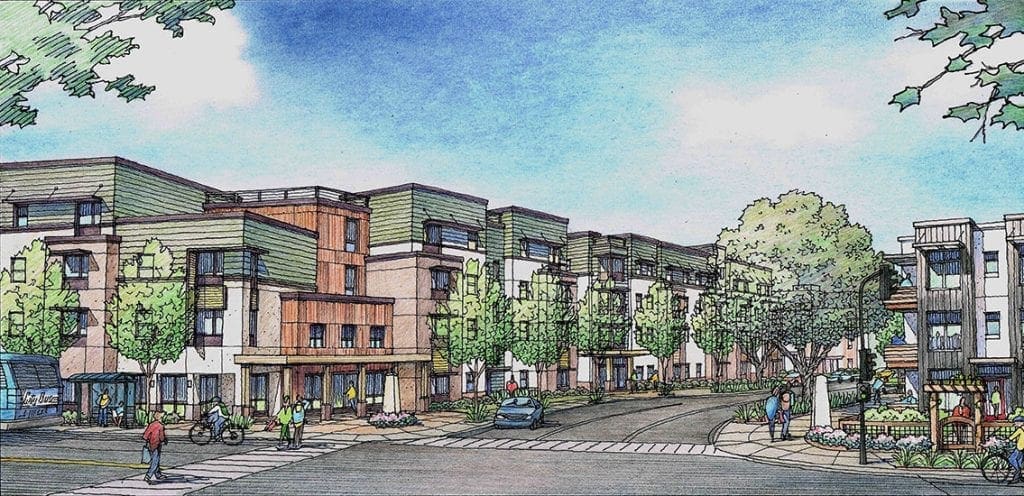
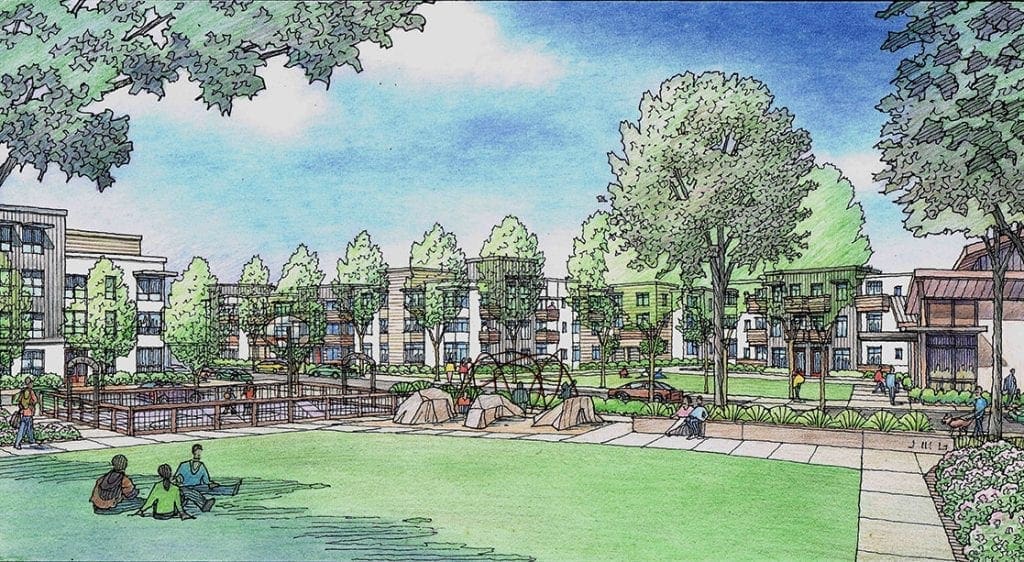
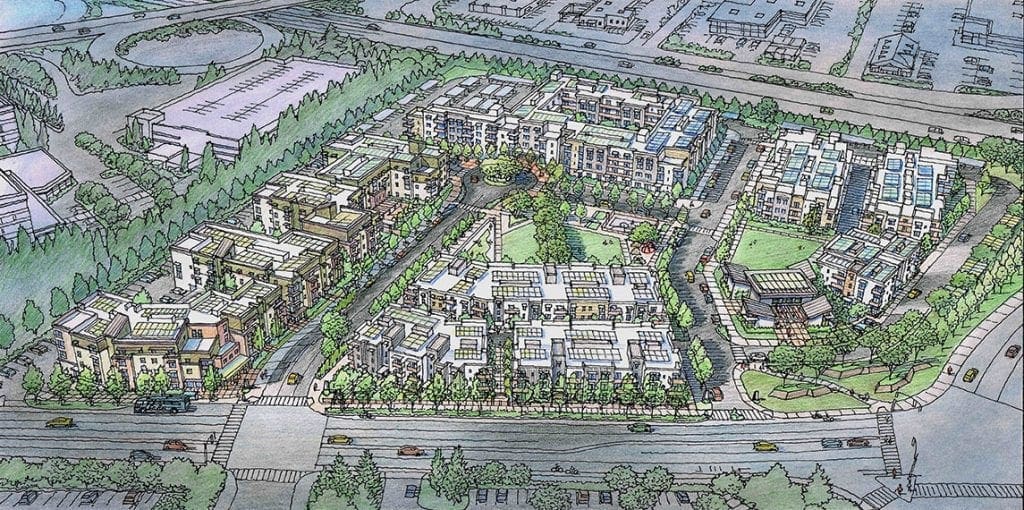
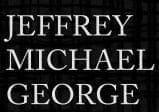
Recent Comments